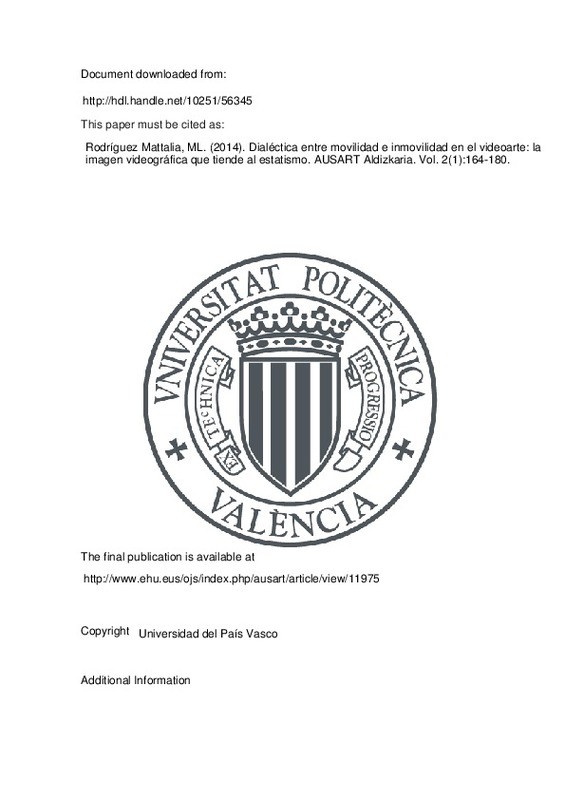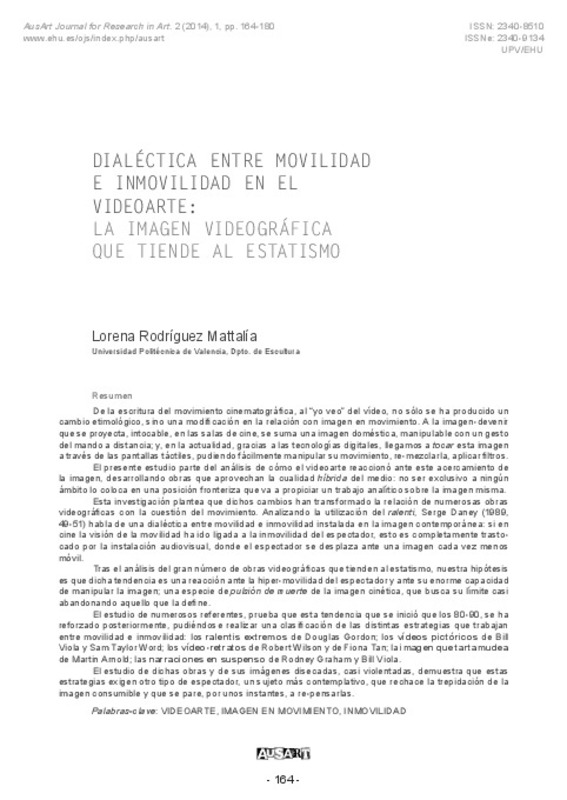JavaScript is disabled for your browser. Some features of this site may not work without it.
Buscar en RiuNet
Listar
Mi cuenta
Estadísticas
Ayuda RiuNet
Admin. UPV
Dialéctica entre movilidad e inmovilidad en el videoarte: la imagen videográfica que tiende al estatismo
Mostrar el registro sencillo del ítem
Ficheros en el ítem
| dc.contributor.author | Rodríguez Mattalia, María Lorena
|
es_ES |
| dc.date.accessioned | 2015-10-22T10:56:39Z | |
| dc.date.available | 2015-10-22T10:56:39Z | |
| dc.date.issued | 2014 | |
| dc.identifier.issn | 2340-8510 | |
| dc.identifier.uri | http://hdl.handle.net/10251/56345 | |
| dc.description.abstract | [EN] The relationship with the moving image has been modified, from film movement script, to the video that allows a personal look. The image that is projected, untouchable, in cinema, is followed by a domestic image, which we can manipulate with a simple touch of the remote control. Today, with digital technologies we can feel this image on touch screens and easily manipulate their movement, re-mix it, apply filters. This study is based on analysis of how video art reacted to this closer image and developed works that take advantage of the hybrid quality of the medium. The videographic medium is not exclusive to any area of the image and is placed in a border position that leads to an analytical work on the image itself. This research proposes that these changes have transformed the relationship of numerous works of video art with the movement. Serge Daney (1989, 49-51) analyzes the use of the decelerated image in video art and concludes that a dialectic exists in the contemporary image between mobility and immobility. In cinema, the vision of mobility has relied on the immobility of the spectator. This is completely transformed by the audiovisual installation, where the viewer moves in front of an increasingly less mobile image. We have analyzed a large number of video works that tends to stillness and our hypothesis is that this trend is a reaction to the new mobility of the spectator and its enormous power for manipulating the image. There is a kind of compulsion to death of the moving image, which seeks its own limit and almost abandons what defines it. The study of numerous works of video, proves that this trend that began in the years 80 and 90, has been subsequently reinforced. We have made a basic classification of the different strategies that work with the mobility and immobility of the image: the Douglas Gordon extremely slow image; the pictorial videos by Bill Viola and Sam Taylor Wood; the video portraits by Robert Wilson and Fiona Tan; the Martin Arnold image that stutters; the stories that cannot advance by Rodney Graham and Bill Viola. The study of these works and their dissected images, shows that these strategies require another type of spectator. These works of art are directed to more contemplative viewers, who reject the trepidation of the image of consumption and stop, for a moment, to think about the image. | es_ES |
| dc.description.abstract | [ES] De la escritura del movimiento cinematográfica, al yo veo del vídeo, no sólo se ha producido un cambio etimológico, sino una modificación en la relación con imagen en movimiento. A la imagen-devenir que se proyecta, intocable, en las salas de cine, se suma una imagen doméstica, manipulable con un gesto del mando a distancia; y, en la actualidad, gracias a las tecnologías digitales, llegamos a tocar esta imagen a través de las pantallas táctiles, pudiendo fácilmente manipular su movimiento, re-mezclarla, aplicar filtros. El presente estudio parte del análisis de cómo el videoarte reaccionó ante este acercamiento de la imagen, desarrollando obras que aprovechan la cualidad híbrida del medio: no ser exclusivo a ningún ámbito lo coloca en una posición fronteriza que va a propiciar un trabajo analítico sobre la imagen misma. Esta investigación plantea que dichos cambios han transformado la relación de numerosas obras videográficas con la cuestión del movimiento. Analizando la utilización del ralenti, Serge Daney (1989, 49-51) habla de una dialéctica entre movilidad e inmovilidad instalada en la imagen contemporánea: si en cine la visión de la movilidad ha ido ligada a la inmovilidad del espectador, esto es completamente trastocado por la instalación audiovisual, donde el espectador se desplaza ante una imagen cada vez menos móvil. Tras el análisis del gran número de obras videográficas que tienden al estatismo, nuestra hipótesis es que dicha tendencia es una reacción ante la hiper-movilidad del espectador y ante su enorme capacidad de manipular la imagen; una especie de pulsión de muerte de la imagen cinética, que busca su límite casi abandonando aquello que la define. El estudio de numerosos referentes, prueba que esta tendencia que se inició que los 80-90, se ha reforzado posteriormente, pudiéndose realizar una clasificación de las distintas estrategias que trabajan entre movilidad e inmovilidad: los ralentis extremos de Douglas Gordon; los vídeos pictóricos de Bill Viola y Sam Taylor Word; los vídeo-retratos de Robert Wilson y de Fiona Tan; la imagen que tartamudea de Martin Arnold; las narraciones en suspenso de Rodney Graham y Bill Viola. El estudio de dichas obras y de sus imágenes disecadas, casi violentadas, demuestra que estas estrategias exigen otro tipo de espectador, un sujeto más contemplativo, que rechace la trepidación de la imagen consumible y que se pare, por unos instantes, a re-pensarlas. | es_ES |
| dc.language | Español | es_ES |
| dc.publisher | Universidad del País Vasco | es_ES |
| dc.relation.ispartof | AUSART Aldizkaria | es_ES |
| dc.rights | Reconocimiento (by) | es_ES |
| dc.subject | Video art | es_ES |
| dc.subject | Moving image | es_ES |
| dc.subject | Immobility | es_ES |
| dc.subject | Videoarte | es_ES |
| dc.subject | Imagen en movimiento | es_ES |
| dc.subject | Inmovilidad | es_ES |
| dc.subject.classification | ESCULTURA | es_ES |
| dc.title | Dialéctica entre movilidad e inmovilidad en el videoarte: la imagen videográfica que tiende al estatismo | es_ES |
| dc.type | Artículo | es_ES |
| dc.rights.accessRights | Abierto | es_ES |
| dc.contributor.affiliation | Universitat Politècnica de València. Departamento de Escultura - Departament d'Escultura | es_ES |
| dc.description.bibliographicCitation | Rodríguez Mattalia, ML. (2014). Dialéctica entre movilidad e inmovilidad en el videoarte: la imagen videográfica que tiende al estatismo. AUSART Aldizkaria. Vol. 2(1):164-180. http://hdl.handle.net/10251/56345 | es_ES |
| dc.description.accrualMethod | S | es_ES |
| dc.relation.publisherversion | http://www.ehu.eus/ojs/index.php/ausart/article/view/11975 | es_ES |
| dc.description.upvformatpinicio | 164 | es_ES |
| dc.description.upvformatpfin | 180 | es_ES |
| dc.type.version | info:eu-repo/semantics/publishedVersion | es_ES |
| dc.description.volume | Vol. 2 | es_ES |
| dc.description.issue | 1 | es_ES |
| dc.relation.senia | 278306 | es_ES |
| dc.identifier.eissn | 2340-9134 | |
| dc.subject.asignatura | Creación audiovisual y práctica artística contemporánea 30034 / L - Máster universitario en producción artística 2033 | es_ES |
| dc.subject.asignatura | Creación audiovisual y práctica artística contemporánea 30034 / W - Programa de doctorado en arte: producción e investigación 2069 | es_ES |







